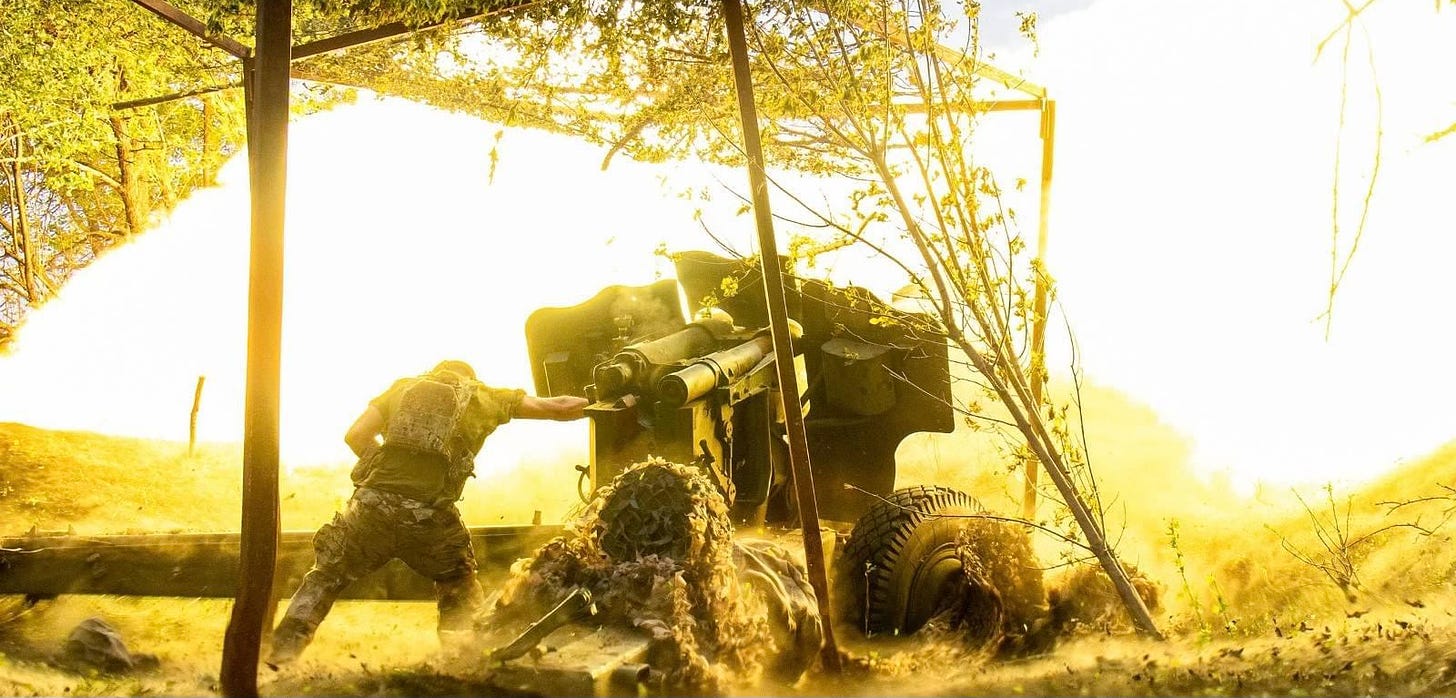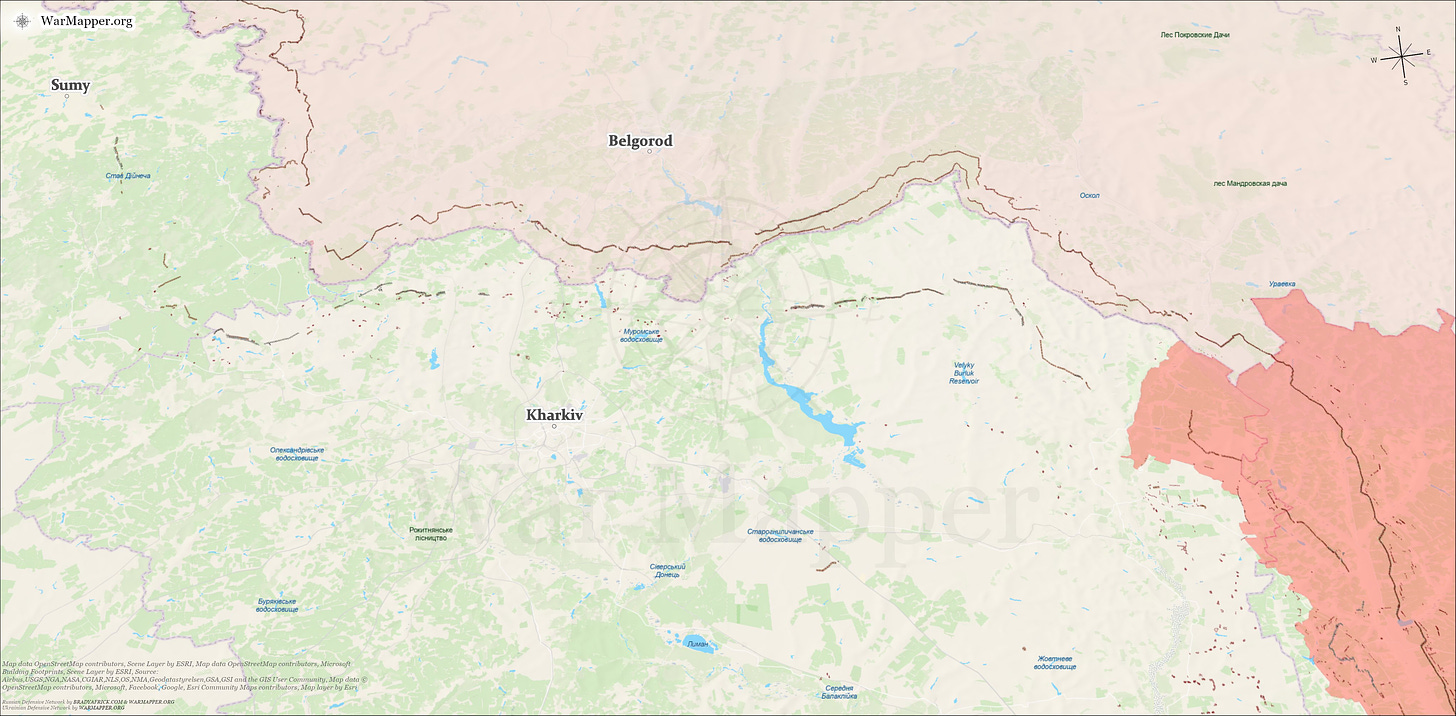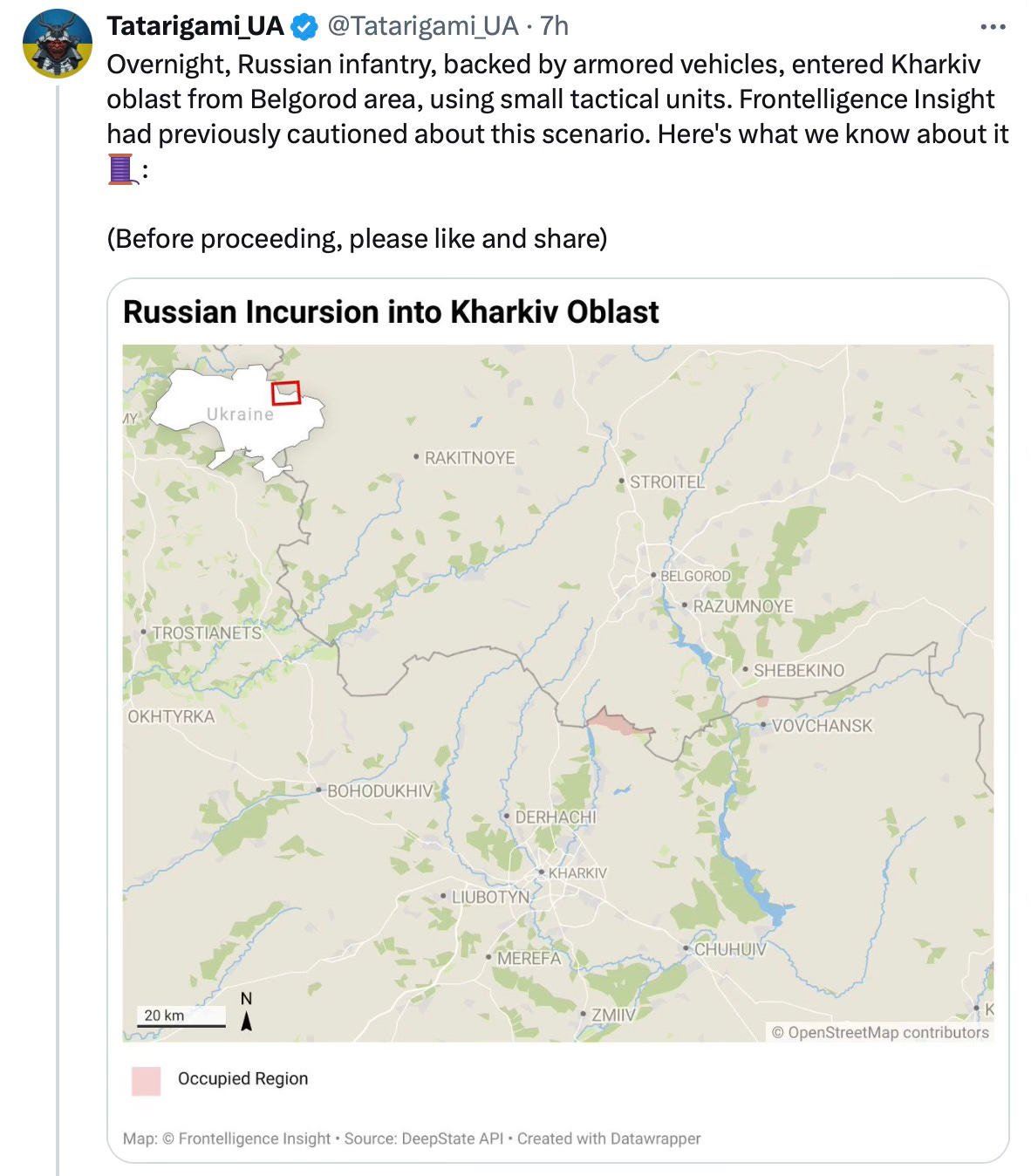Today, Russian forces attempted to expand their operations against Ukraine in the Kharkiv region. We know the size of the occupiers' forces and their intentions. Our warriors, artillery, and drones are fighting back against the occupier. I thank each soldier, sergeant, and officer who is defending our positions. We are strengthening Kharkiv directions…We also continue to actively prepare for the Global Peace Summit.
This morning, we learned that the Russians have commenced offensive operations on a new front in northeastern Ukraine. The scope of the new Russian Kharkiv offensive remains unclear. However, it will place greater pressure on the stretched Ukrainian armed forces.
This is an initial assessment, noting there is an abundance of ambiguity at this time.
The Ukrainian military leadership have been telegraphing other Russian offensive operations for some time. Recently, the deputy head of Ukrainian military intelligence Major General Vadym Skibitsky, described in an interview with The Economist how “things are as difficult as they have ever been since the early days of Russia’s full-scale invasion. And they are about to get worse…our problem is very simple: we have no weapons. We always knew April and May would be a difficult time for us.”
So, while the timing may be a tactical surprise, this has been an offensive that the Ukrainians have been anticipating for time. Many of those who analyse the war have also been exploring the potential for a larger Russian offensive as well. In a recent assessment I wrote that:
In seizing more territory, Russia increases the military and political challenges faced by Ukraine in the short term. And while this window of opportunity identified by the Russians may slowly close as western defence industry expands its production, more Western weapons arrive and the Ukrainians mobilise more troops, it is likely the coming weeks will be a very grim affair for the Ukrainian ground forces in the east.
Russia is Continuing to Exploit a Window of Opportunity
This latest Russian thrust into Ukraine is part of a months-long campaign by the Russians to exploit opportunities they perceived in the wake of the failed 2023 Ukrainian counteroffensive.
Their offensive operations are exploiting several tactical, operational and strategic opportunities that have become apparent since the end of 2023. First, the culmination and failure of the 2023 Ukrainian counteroffensives will be something that the Russians saw as an opportunity. Once the Ukrainians culminated in the back half of 2023, the Russians will have been well placed to resume the offensive given the lack of major Ukrainian breakthroughs.
Another opportunity being exploited by Russia is the shortfall in Ukrainian defences constructed in the east. While the Ukrainians eventually began building several lines of defences in the east, it has been a slow process. There are defensive zones established in the northeast, but they are yet to achieve the same depth of the Russian Surovikin line. The map below from @war_mapper shows the locations, and disparity in defensive lines, across the Kharkiv region.
The Russians are also making the most of two converging tactical opportunities: the shortfalls in unit strengths of Ukrainian front-line units, and the shortfalls of munitions for Ukrainian artillery and battlefield air defence. However, the Russians will be anticipating Ukrainian mobilization and an increased flow of western military assistance eventually narrowing this gap between Ukrainian and Russian manpower and firepower (it probably won’t close it).
Until that happens sometime in the coming weeks (or months), the Russians will be seeking to exploit this window of opportunity to the maximum extent possible. This Kharkiv offensive appears to be yet another way they are doing so.
Ukrainian Reserves
Ukraine does have some reserves that it can use to respond to the Russian advance into Kharkiv. It has recently rotated some brigades in the east.
However, the Ukrainian high command will need to make hard decisions about whether Kharkiv is a significant push - and becoming the Russian main effort - or an effort to draw Ukrainian forces from further south.
Russia is known to have at least two Corps in the region that are uncommitted. These ground forces – whose quality is probably questionable - could be used as exploitation forces if the current offensive is able to successfully advance well into Ukraine. With shortfalls in Ukrainian artillery, this Russian advance will also make use of a Russian superior quantity of firepower. The Russian advance will also probably be led by the employment of large, air-launched glide bombs, as Russia has learned to do elsewhere, to create breaches in Ukraine’s tactical defences.
That said, this Russian force is of insufficient size to seize a city the size of Kharkiv, Ukraine’s second largest city. It could however hold it at risk with increased artillery strikes. This would seek to achieve one of Russia’s key aims, which is causing panic among civilians and depopulating eastern Ukraine.
Regardless, the new Russian front will place the Ukrainians in a dilemma about where to deploy their reserves. As Russian aims become clearer in the coming days, the Ukrainians will have a better sense about whether this is the new Russian main effort or just a secondary effort to support their operations further to the south.
Other Initial Assessments
Two other initial assessments on this new Russian offensive are worth reviewing.
First, the initial assessment from @Tatarigami_UA is worth a read. As it states, at this time there is significant uncertainty about Russian objectives.
Second, the initial assessment from the Institute for the Study of War is also worth reviewing.
Assessment
Russia will be aiming to use this ‘surprise’ attack to dent Ukrainian morale - both civilian and military. It will also wish to use advances on this new front to impact opinion in the West and beyond to support its narrative of ‘inevitable Russian victory’ in this war. Although, having just celebrated a 3rd Victory Day without a victory, a Russian victory is far from inevitable.
While the attacks at present appear to be small in scale, they have made a useful tactical penetration into Ukraine. It will force a shakeup in Ukrainian dispositions across the east of the country. And with at least two Corps available, this is an operation that the Russians can sustain for some time depending on their ultimate objectives. While capturing Kharkiv would require a much larger force and would need to be the Russian main effort to succeed, capturing additional Ukrainian territory might posture the Russians well for subsequent operations in Kharkiv.
Given the current firepower and personnel asymmetry between Russia and Ukraine, this new front in northeastern Ukraine will be a severe test of Ukraine’s ability to respond. It may be one of the toughest moments for Ukraine in the war so far.
As they have for the past several months, the Ukrainians face a dilemma of maintaining their army or holding territory. With this new Russian front, it is going to be impossible to do both. And this is both a military and political issue. If the Ukrainians decide to hold ground at all costs, they will lose more of their increasingly smaller army; if they chose to preserve their army, they will have to give up ground.
And of course, this could all fizzle out to nothing. The Russians have mastered the art of launching attacks that go nowhere in the past two years.
Like all new military offensives, the first few hours and days are shrouded in ambiguity for those observing them. We will need to watch the degree to which Russia commits other ground and air forces here, compared to other axes of advance, before we have a better sense of just how perilous the Ukrainian position is in Kharkiv.






